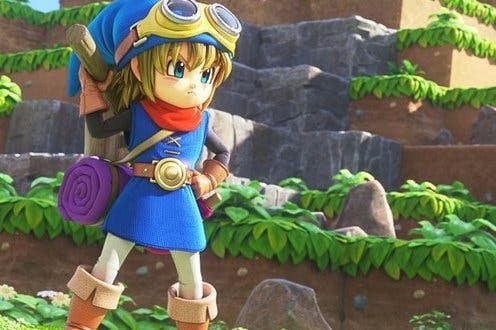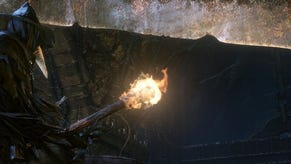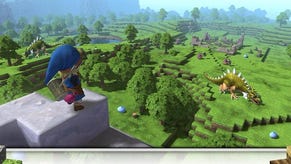Dragon Quest Builders review
Slimecraft.
Minecraft has a way of tapping into the deepest parts of us: the primordial instinct to survive the night and, once through it, to spend the day in creative endeavour. Through its stubby vision we learn to wrangle the land, refining elements and building first a cave, then a castle, then a computer. Dragon Quest Builders takes up the elemental themes, just as it takes up Minecraft's world-conquering template before attempting to refine it into something new.
The citizens of Alefgard may have survived decades of embattlement at the claws of the local monsters, but they have lost something fundamental to their humanity: the ability to build. Stripped of this species-defining quality, civilisation has fallen to ruins. Tumbledown houses sit unrepaired. Ghosts wander crumbled castles' breezy halls, mourning time's blows to the memory of past glories. People wander sleep-deprived; they've forgotten even how to make a bed.
You awake from a thick slumber, in the Japanese RPG tradition, as the chosen one. This time, however, your destiny is not that of the warrior, but of the hard-hatted construction worker - the gift of crafting is yours alone. Guided by a sassy spirit voice, you begin the blistering work of rebuilding the Alefgardian's world, restoring their homes, installing their ovens and, through some creative interior decoration, rejuvenating their spirits. It's a premise plucked from the daytime TV schedule - the foppish designer, airlifted into a site of municipal catastrophe with a hacksaw, some white paint and a pocketful of flower seeds - but, once you've hacked your way through the spun-out tutorials, it works exceptionally well.
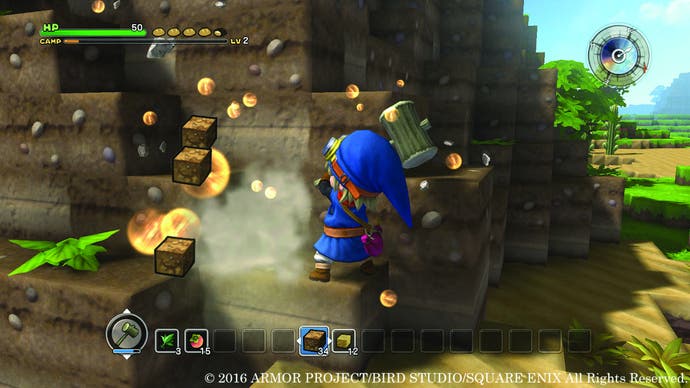
After 30 years, Dragon Quest's designers know only too well how to make you feel like an indispensible hero on whom entire civilizations depend. This game's genius is the way in which it localises the heroics. You begin by restoring a single house, for a somewhat bewildered Alrfgardian who, once you're done working (a house must have a door, a light source and enclosed walls at least two blocks high), is finally able to get a good and warm night's sleep. Your work soon attracts other would-be residents (many of whom you meet in the Slime-infested wilds and bring to the settlement) and, in this way, as the population grows so the hamlet becomes a village, becomes a town, becomes a city.
Rather than earn experiences points for your character, the town itself levels up. You earn points for the number of buildings, and the quality, range and number of their furnishings. By tying score to renovation, experimentation is encouraged, like a gamified Grand Designs. Finding new objects to craft is as simple as discovering new materials in the world. Find a way to knock down a tree, for example, and you'll be able to shape it into a plank of wood, which then opens up a raft of new building opportunities when you next approach your crafting table, from fine wooden flooring to park benches.
The citizens of your town are not mere freeloaders. At set points, your town is besieged by a horde of monsters during the night. Your neighbours become comrades along whom you fight, further strengthening the bond between player, NPC and town. It's masterly design. Likewise, install a wooden chest in each room in your town, and your fellow citizens will work during the daytime, mining and storing resources and even building objects and cooking food (Maintaining a constant intake of calories is necessary to keep your character fighting, and building, fit.) They also act as quest-dispensers, sending you off on all manner of errands which slowly take your deeper into the world ("What did your last slave die of," your character says to one particularly demanding NPC, with typical Dragon Quest-style attitude).
While Dragon Quest Builders' map is, unlike Minecraft, standardised for every new player in order to allow the story to be effective paced and, crucially, to ensure that players cannot destroy plot-crucial environmental features, it is nevertheless vast and unfurling. Portals can be used to flit between landmasses, but some islands can only be reached by physically building a bridge, block by block. The world is given added texture and interest by a cast of characters that can be found dotted everywhere: a friendly monster in a cave here, a ghostly figure atop a battlement there. In Minecraft, your sense of wonder was limited to the discovery of new and marvellous topography. In Dragon Quest Builders, that same environmental draw exists, but it's further bolstered by the knowledge that over this hill or across that lake, you might just find a stranger who can be made a neighbour.
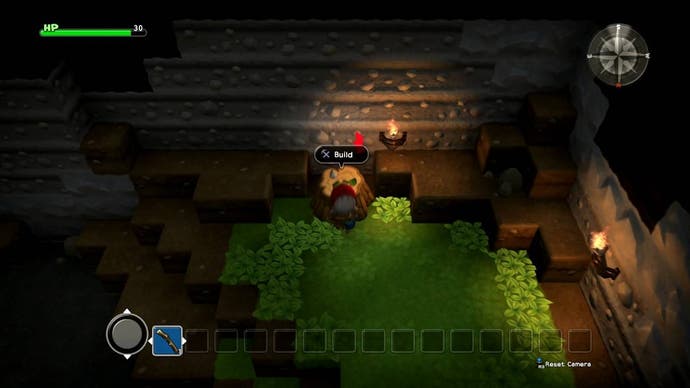
The core elements are shared with Minecraft, then, but this is an entirely new kind of construction. The storytelling even benefits from the third person perspective, facilitating slapstick humour (when your character's armour is worn out she will run around in her knickers till you replace it) and reaction shots. So too does the combat, which builds in pleasing ways over the course of the expansive story, as you learn how to craft better and different types of weapon, and even learn new attacks from defeated boss monsters.
These are old and familiar design tricks, perhaps, made fresh through a novel setting. But where Dragon Quest Builders strikes a new kind of gold is in the deep and protective relationship that blooms between player and town. Once you've redecorated your town's communal kitchen, you'll happily spend the time harvesting new elements with which to build defensive battlements, in order to stave off the next wave of attackers. When a plucky monster manages to break your defences and knock a window out, you'll feel rage. In this way, your own story meshes, delightfully, with the prefabricated plot told by the game's designers.
Years ago Minecraft's original designers felt compelled to add a story to their sandbox hit, in order to impose some kind of formal structure to the playpen. The reward for completing that somewhat tepid storyline was some poetry, written by the Irish novelist Julian Gough. One stanza seems to anticipate, if not Dragon Quest Builders, then the idea that all works of mystical creativity build upon those that came before. 'And the game was over and the player woke up from the dream,' it reads. 'And the player began a new dream. And the player dreamed again, dreamed better.'
